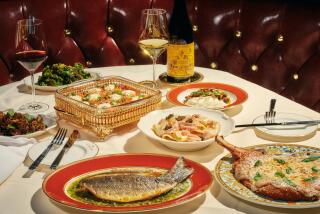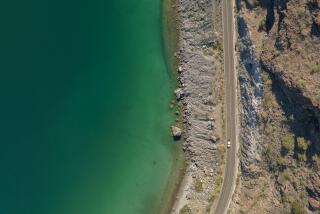Zigzagging Through the Azores
- Share via
TERCEIRA, Portugal — As my husband, Edward, and I waited at a bus stop, we chatted with a local man in English and broken Portuguese. Obviously puzzled, the man suddenly asked, “Are you a little bit Portuguese?”
We were charmed by the way he put his question, one that was asked of us often during a three-week exploration of the Azores. Americans who find their way to these nine Portuguese islands--about 800 miles off the mainland, or “on the outskirts of Europe,” as one book put it--are largely descendants of emigrants. About 130,000 Azoreans moved to North America between 1955 and 1974 as the local economy struggled.
Other visitors are mostly Portuguese from the mainland, Germans, English, French and Italians. Americans without Portuguese roots, like us, are far fewer.
The islands have no casinos, no mega-malls, little night life and few sandy beaches to draw throngs of tourists. But in the words of one American visitor we met, the attraction is obvious: “Beauty, beauty everywhere.”
This world of natural wonders was sculpted by volcanic upheavals that still rearrange the landscape. On the coasts, rocky headlands are lashed by the sea. Inland, crater lakes, hot springs and collapsed volcanic cones dot the land. In other areas, sweeping green fields form a tapestry threaded with black basalt walls and miles of white and blue hydrangea hedges.
The Azores’ natural wonders aren’t limited to the landscape. We found the people to be wonders for their exceptional warmth and kindness: the man who invited us into his home and served us passion-fruit liqueur; the shop clerk who told us, “When you pass the shop again, say me hi”; the man who drove us to a restaurant because none was within easy walking distance. A chambermaid at one inn even gave us handmade potholders on our departure.
Our interest in the Azores sprang from two previous trips to mainland Portugal and to Madeira, another Portuguese island, off the coast of Morocco.
In the Azores, each island has its own personality, as we learned last September. We started on Sao Miguel, 40 miles long by 10 miles wide and home to half of the Azores’ 240,000 residents. It’s the richest in attractions, natural and man-made. We flew from Boston to Ponta Delgada, the largest town and the seat of the Azores’ autonomous government.
After a 4 1/2-hour flight, we stepped off the plane and were dazzled by the brilliance of the light, the clarity of the air and the intensely green landscape. The weather is capricious--one day we watched the skies alternate between full sun and showers five times in seven hours. But for the most part, thanks to the Gulf Stream, the climate is mild year-round. High temperatures range between 55 and 76 degrees, with high humidity to make days feel warmer.
We checked into the Residencial America, a pleasant, 20-room inn. The town does have upscale hotels, but we opted for a more economical pensao to get a better taste of local life.
We toured Ponta Delgada’s historic quarter, which lies behind the broad boulevard fronting the harbor. Walking on smooth black and white stones set in varying designs, we reached three adjacent landmarks: the 17th century town hall; the 18th century town gate, with its triple arches; and the 16th century church of Sao Sebastiao, famed for its Manueline facade, Baroque doorways and high altar of carved cedar.
Trips outside of Ponta Delgada provided a look at rural life. Farmers rode burros or drove horse carts carrying shiny metal milk cans. Yellow flowers of wild ginger and rose-colored belladonna lilies bloomed.
Sete Cidades, accessible by taxi or car and about 40 minutes west of Ponta Delgada, is one of the most popular attractions. A volcanic crater cradles side-by-side twin lakes, about seven miles around in total. One lake is blue and the other green, though no one could explain why.
A day trip to Furnas excited us even more. A 1 1/2-hour bus ride took us to this village pocked with fumaroles, openings in the earth spewing pungent sulfur fumes and tall columns of steam. Boiling water from deep underground bubbled up into puddles.
The earth next to Lake Furnas is so hot that locals use it as an oven. They set a metal pot of food into an underground pit and cover it with a wooden lid. Five hours later, the cozido--beef cubes, chicken, sausage, blood pudding, potatoes, carrots, cabbage and rice--is ready to eat. Several Furnas restaurants offer this specialty brought from the lake.
We spent a week exploring Sao Miguel’s other attractions: the Baroque churches; the outstanding Carlos Machado Museum, with its exhibits on natural history and folklore in a 17th century former convent; and the public market, selling fruits, vegetables, cheese, meat, fish, flowers and baskets. We could have stayed longer, but other Azores isles beckoned.
Our next stop was Horta on the island of Faial (pronounced fa-YALL), the westernmost island in the central group and a 45-minute flight away. Faial brims with nautical flavor, with Horta’s sheltered harbor and huge marina serving as a focal point.
International pleasure craft that dock here don’t depart without leaving their mark: Using the long concrete quay (wharf) as a canvas, crews depict their visit in paint, including the date and their names in the picture. Sailors who disregard the custom are said to suffer bad luck.
The northwest tip of Faial is like the set of a science-fiction movie, a stark, charcoal-colored lunar landscape almost devoid of vegetation. It’s the product of underwater explosions just offshore in 1957 and 1958 that signaled the birth of a volcano rising from the ocean. For 13 months, Capelinhos spouted gases, ash and lava that swallowed part of a lighthouse and created an isthmus linking it to the island. The small Volcanic Museum of Capelinhos displays artifacts and photos of eruptions.
A half-hour ferry ride from Faial took us to Pico, our third stop. The island’s crowning feature is a volcano of the same name. At 7,711 feet, it’s the highest point in Portugal.
Rather than tour the island by rental car, Edward and I hired a cab with an English-speaking driver for about $10 an hour. Our driver was Maria Leo, a young woman who showed us Pico’s history as the Azores’ whaling center.
Azoreans didn’t hunt the animals until New England whalers recruited them a century ago. Maria took us to the former whale processing factory in Sao Roque, now a museum, and the Whaling Museum in Lajes (LA-zhis).
Maria said her mother told her that the unusable parts of the carcass were dumped into the ocean. “You couldn’t swim in the sea, and you couldn’t stand the smell,” Maria’s mother said. Homemakers blocked windowsills and thresholds to stem the stench. Thankfully, since whaling was banned in 1982, whale watching has supplanted whale hunting.
Northeast of Pico lies Sao Jorge (Sow ZHAR-zeh), an island that wasn’t on our itinerary until several Azoreans recommended it. They steered us right. The string bean-shaped island is rural and rugged, with a landscape that sent our spirits soaring.
In the summer, a boat links the central Azores. Because the boat season was ending, we flew to Velas, Sao Jorge’s biggest town. Edward and I found a cabdriver, Amaro Oliveira, who had lived in Canada for 10 years and has grown children in California but who had returned to his birthplace. “Less stress,” he said, “and here, good air for breathing.”
On this island, dairy cows outnumber people. So Amaro showed us a cheese factory where employees broke up milk curds after the whey was removed. The island’s most famous product is a rich cheese, also named Sao Jorge, which has plenty of bite and is served as an appetizer in restaurants. As we drove past cows tilting on the island’s steep slopes, Amaro joked that each had two legs shorter than the others.
He also took us to the church of Santa Barbara, one of the Azores’ prettiest. The old section of the Baroque church was built in 1485, the “new” in 1770. The interior is decorated with glazed tiles, carved and gilded altars, statuary and carved wooden bas-reliefs painted in a carnival of colors.
But nothing could rival Sao Jorge’s landscape, especially on the steep north coast, which is popular with hikers. The collapsed escarpment faces here have created fajas--flat, fan-shaped deposits of fertile soil along the shoreline. From the Miradouro do Fajados Cubres, an overlook more than 2,000 feet high, the panorama was phenomenal. The fajas far, far below, where the orchards and vineyards grow, resembled the scallops on a petticoat.
The island of Terceira (ter-SEAR-ah), a 20-minute flight east, feels different from Sao Jorge, its terrain gentler and the capital of Angra do Heroismo relatively cosmopolitan.
In 1983, UNESCO declared Angra a World Heritage Site in recognition of its wealth of 17th and 18th century mansions, churches and palaces.
Residents are equally proud of the island’s long, beige beach, rare in the Azores; of the seawater swimming pools hewn out of natural rock on the coast; and of an inactive volcanic chimney, Algar do Carvao, 148 feet deep (bring a flashlight).
The island’s special appeal lies in its traditional festivals and customs. Celebrations honoring the Holy Spirit--festivals brought from the mainland by early settlers--are held throughout the islands, but the custom is strongest on Terceira, where they are celebrated from Easter through August in village after village. Small, brightly painted chapels called imperios are the focal points of ceremonies that include dancing, brass bands and the distribution of bread, wine and soup, reflecting the festivals’ charitable origin.
Lois Brunner Bastian is a freelance writer living in New Jersey.
The island’s tourada a corda (bullfight with a rope) is unique. A bull is released in the street while tied to a rope held by men. Macho young men taunt the bull and move within its reach. As the bull charges, they rush to safety. At our first tourada, the animal moved faster and farther than we expected. With a shiver of fear, we fled when it barreled in our direction.
The night before our flight home, we were back on Sao Miguel, dining at a Ponta Delgada restaurant we had patronized several times. Throughout our trip we had gorged on excellent and unusual fish, grilled squid, octopus and limpets, a shellfish I hadn’t tasted before. For dessert we chose locally grown pineapple, unfailingly sweet and juicy. When we told Pedro, the waiter, that our vacation was over, he replied with a sigh, “The good things finish quickly.”
So true. But in our minds, the Azores are not finished. We returned to the States knowing that four other islands await for next time.
(BEGIN TEXT OF INFOBOX / INFOGRAPHIC)
GUIDEBOOK
Azores, A to Z
Getting there: US Airways flies from LAX to Boston, with a connecting flight on TAP Air Portugal direct to Terceira, the Azores. Or fly any carrier to Newark, N.J., and connect on TAP to Terceira, with a stop in Lisbon. Round trips start at $722.
Where to stay: I liked the Residencial America in Ponta Delgada, Sao Miguel. A double room was $35, including continental breakfast; telephone 011-351-296-284351. The Portuguese National Tourist Office, tel. (800) PORTUGAL (767-8842), has leaflets listing other lodgings.
When to go: Weather is temperate all year but warmest May through September.
For more information: Internet https://www.multi.pt/ azores.
More to Read
Sign up for The Wild
We’ll help you find the best places to hike, bike and run, as well as the perfect silent spots for meditation and yoga.
You may occasionally receive promotional content from the Los Angeles Times.






